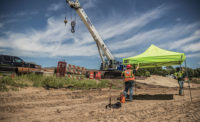These numbers are shocking, period — even more so because they are 100-percent preventable. Ignoring early warning signs like mild heat discomfort, sweating or excessive thirst can quickly lead to heat-related illness (HRI) extremes, including heat stroke and even death. Planning and preparedness are no longer luxuries but necessities when it comes to HRI prevention.
Bottom line: Heat stress is a growing problem for workers, and it’s time to address this issue head on.
In the zone
No two work zones are the same. Outdoor workers encounter a multitude of diverse environments and often suffer the most from temperature extremes. While outdoor hazards may be obvious, indoor workers should not be forgotten as they can suffer from the very same extreme temperatures.
Unfortunately, the safety concerns at an indoor work zone often go unnoticed because the environment isn’t perceived as extreme as an outdoor environment.
Regardless of the location or the job, it’s critical to first look to engineer out the issue and work to limit the risk as much as possible. When that isn’t feasible, a combination of administrative controls and personal protective equipment (PPE) are the recommended approach. The list of solutions may include:
Shade
One preemptive method to ensure that workers are protected on the job is to implement onsite areas that serve as a refuge from the heat. Within these “zones” there should be easy access to shade, fluids for drinking and an air-conditioned (AC) room or a well-ventilated zone where workers can rest. Tents, fans, AC-equipped trailers and drinking stations are all effective solutions to keep workers cool and safe. In certain states, such as California, mandatory shelters are enforced when the temperature reaches 85 degrees Fahrenheit.
Hydration
Workers lose an average of 2-3 gallons of fluid through sweat, urination and even breathing while working in heat. So in addition to providing these safety zones with water, it is important to get workers to actively hydrate before, during and after their shifts while also monitoring the fluid levels at certain intervals during the day.
A weigh-in program done before, after and during shifts can help determine if any fluid has been lost. When replenishing, a worker should drink 2 cups (1/2 quart) of water for every pound lost during a shift. Additionally, monitoring urine color with a urine color chart can be an effective way of helping keep hydration a priority, as urine color is often the first sign of dehydration. Employers should place urine charts in bathrooms for workers to keep hydration top of mind.
Remember, water is the best fluid to use when maintaining fluid levels; however, if cramping occurs, electrolyte solutions should be substituted. Providing workers with personal hydration solutions that they can carry with them to their jobsite (if conducive) will also help encourage hydration. Reusable water bottles or hydration packs are perfect solutions that provide water “on the spot,” so workers don’t have to leave their work zone.
Education & training
Educating the workforce is mission critical for executing a successful HRI prevention program. Specific objectives for both workers and supervisors should be clearly outlined and enforced. For workers, heat stress training should be required for all new hires as well as for current staff at the beginning of every warm weather season. For supervisors, training should occur prior to starting in an administrative role and before the start of every warm season. Training should cover best practices that a supervisor is responsible for providing.
Written procedures
Emergency procedures should be posted in written form at every worksite location, so they are available for workers and any state OSHA representative to see. These procedures should detail how the company will:
Provide access to water and shade
Monitor the weather
Institute high heat procedures and address lack of acclimatization
Train all employees and supervisors
Respond to heat-related illnesses without delay
Provide first aid and emergency services
Provide clear and precise directions to the worksite
These procedures are based on the California OSHA standard (Title 8, section 3395) addressing heat stress prevention. Specific requirements related to warm weather procedures vary by state, so employers should consult their state occupational safety and health board for details.
PPE
Along with knowing the signs and symptoms of heat stress, it is important to know how to protect against the physical factors of hot environments. Personal Protective Equipment (PPE) is another way to limit worker susceptibility to HRIs. Brimmed hats and light colored material are two examples of reducing direct exposure to the sun. Additionally, incorporating fast drying absorptive material helps keep workers cool and trap sweat, preventing it from getting in workers’ eyes and on their hands.
Evaporative cooling bandanas, triangle hats and hard hat inserts keep workers cool using an evaporative cooling process that results in a significantly cooler temperature than ambient air. Placing one of these products in an area where large blood vessels are located near the surface of the skin can help keep workers’ core body temperatures in check. Options for placement are on the neck, crook of the arm, groin, or armpits. Cooling vests can also be worn to help maintain a safe core body temperature, especially if an application requires workers to wear heavy protective gear such as body armor or full body protective suits.
Prevention is key
Heat-related illness is a serious issue — but the good news is that it is 100-percent preventable. Taking a few key steps for planning to prevent an HRI is far better than planning how to deal with it once it becomes an issue. Providing proper training, facilities, equipment and administrative SOPs for HRIs; being aware of the early warning signs; and following steps to minimize workplace risks are all key components to keeping productivity thriving and safety priority number one — even when the heat is on.
Works cited
1. “OSHA Renews Heat Illness Prevention Campaign,” Occupational Health & Safety, accessed February, 2013, http://ohsonline.com/articles/2012/05/07/osha-renews-heat-illness-prevention-campaign.aspx
2. “U.S. Bureau of Labor Statistics.” Table A-9, accessed March, 2013, http://www.bls.gov/iif/oshwc/cfoi/cftb0267.pdf
3. “Outdoor Heat Exposure Rule,” Washington State Department of Labor Industries, accessed February, 2013, http://www.lni.wa.gov/Safety/topics/atoz/heatstress/default.asp
4. “Heat Related Illness Prevention," State of California Department of Industrial Relations, accessed February, 2013, http://www.dir.ca.gov/DOSH/HeatIllnessInfo.html
5. “Heat Stress Guide,” Minnesota Department of Labor and Industry, accessed February, 2013, http://www.dli.mn.gov/OSHA/PDF/heat_stress_guide.pdf
6. "U.S. Bureau of Labor Statistics." http://www.bls.gov/


